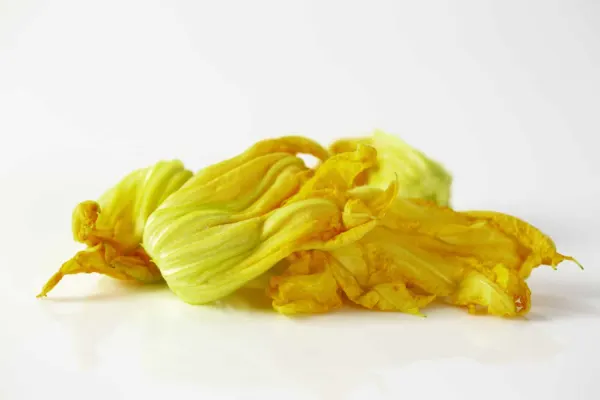Access our First Foods® Database in the Solid Starts App.
Learn moreSquash Blossoms
Flower
Age Suggestion
6 months
Iron-Rich
No
Common Allergen
No

When can babies eat squash blossoms?
Squash blossoms may be introduced as soon as baby is ready to start solids, which is generally around 6 months of age. Take care when introducing squash blossoms, as whole flowers can pose a choking risk.
How do you introduce squash blossoms to babies with baby-led weaning?
Every baby develops on their own timeline, and the suggestions on how to cut or prepare particular foods are generalizations for a broad audience.
6 to 12 months old:
Finely chop squash blossoms, then fold them into other foods, from bean burgers or egg dishes to soft scoopable foods like corn grits, mashed vegetables, or yogurt. Mash the finely chopped squash blossom into goat cheese, ricotta cheese, or unsalted butter for a tangy topping to spread on a teething rusk, thin rice cake, or toast. Uncooked squash blossom, when chopped, shouldn’t pose any additional choking risk, but if the texture makes you uncomfortable, cook thoroughly prior to mixing.
12 to 24 months old:
Continue serving finely chopped squash blossoms in balls, patties, stewed meats, and scoopable foods like grain porridges, mashed vegetables, and spreads. As a child’s chewing skills become more coordinated and you gain confidence in their ability to chew and either swallow or spit out food, you might try offering a whole squash blossom. It’s okay if the child chews and spits out the food at first—they are learning! Coach the child by modeling how to bite and fully chew a food like raw squash blossom. Showing how it’s done by eating alongside the child can go a long way towards helping a toddler learn. At this age, you can also introduce the occasional fried squash blossom, cut into bite-sized pieces, although it is best to keep fried foods like this to a minimum.
If you need some visual reminders of what to do and what not to do with baby at the table, print our Do’s & Don’ts of Raising a Happy, Independent Eater tip sheet.
Videos
Are squash blossoms a common choking hazard for babies?
Yes. Whole flowers, when left intact, are potential choking hazards as they can be challenging to chew. To minimize the risk, chop squash blossoms before offering to babies. As always, make sure you create a safe eating environment and stay within an arm’s reach of baby during meals. For more information on choking, visit our sections on gagging and choking and familiarize yourself with the list of common choking hazards.
Are squash blossoms a common allergen?
No. Allergies to squash blossoms are rare, though individuals who are allergic to Cucurbitaceae fruits (such as cucumber, zucchini, pumpkin, muskmelon, or watermelon) may be sensitive to squash blossoms.
As you would when introducing any new food, start by offering a small quantity for the first few servings. If there is no adverse reaction, gradually increase the quantity over future meals.
Are squash blossoms healthy for babies?
Yes. Squash blossoms contain some folate, a B-vitamin that supports neurological development, as well as small amounts of protein and a number of trace minerals that contribute to the healthy function of many body systems. That said, these edible flowers are overall low in calories and other nutrients needed for healthy growth, so they are best used as one component of nutrient-dense meals for babies and children.
If you would like to cook with squash blossoms but they aren’t in season, you may be able to find them canned. Canned produce is often high in sodium, so drain and rinse canned squash blossoms before cooking to try to reduce sodium levels.
★Tip: Use fresh squash blossoms soon after purchasing or harvesting, ideally the same day, as they are delicate and have a short shelf-life. Store blossoms on a baking sheet, lined with paper towels to absorb excess moisture, in the fridge.
Where do squash blossoms come from?
Squash blossoms transform from edible flowers to plump gourds when left to grow on the vine. From butternut squash to chayote to cucumber, there are as many different kinds of blossoms as there are squash in the plant’s sprawling family tree. Humans have been eating squash since Indigenous peoples learned to cultivate the native fruit in Mesoamerica, and European colonization and global trade later brought the seeds worldwide, where they were bred into the hundreds of gourd, pumpkin, and squash varieties that exist today. One of the most beloved blooms comes from the variety known as zucchini. Also called courgette flower, flor de calabaza, and marrow flower, zucchini flowers are highly perishable, so look for them at local farmer’s markets rather than national chain stores.
What are recipe ideas for cooking with squash blossoms?
From the fiori di zucca in Italy to the hobak-kkok jeon in Korea to the kabak çiçeği in Turkey, cooks like to stuff squash blossoms with cheese, meat, or rice, then batter and fry the blooms in hot oil. It’s best to limit fried and salty foods like these for babies and toddlers, but there are lots of ways for the whole family to enjoy squash blossoms. Squash blossoms can be eaten raw or cooked. When raw, squash blossoms add a delicate grassy taste to herb butters, cheese spreads, grains and pastas, and salads. The flavor mellows once cooked into baked goods, egg dishes, pupusas, stews, and vegetable stir-fries. One easy recipe to get you started: a frittata inspired by the delicious flavors of tlayuda de flor de calabaza, a quesadilla with squash blossom and quesillo found in the open-air markets in Oaxaca, Mexico.
Our Team
Written by
Expert Tips Delivered to Your Inbox
Sign up for weekly tips, recipes and more!
Copyright © 2025 • Solid Starts Inc









